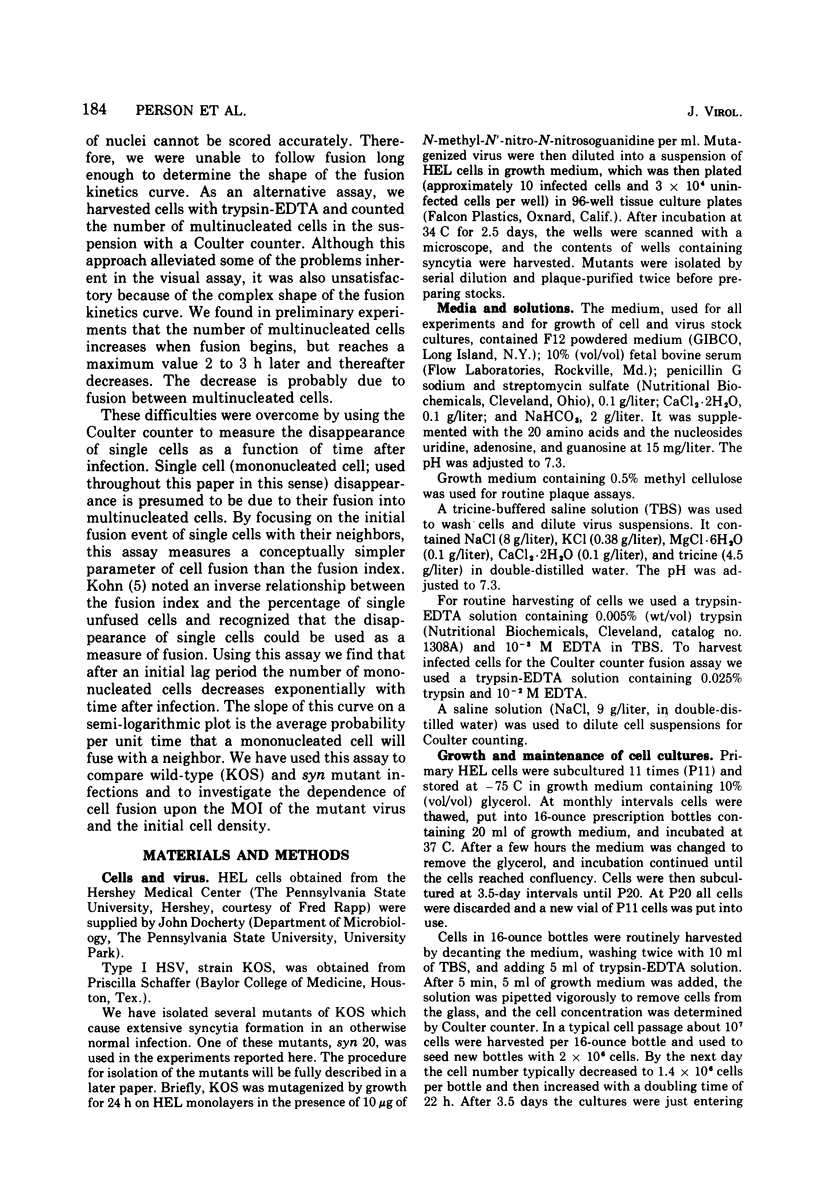Abstract
We have isolated a number of plaque-morphology mutants from a strain of herpes simplex virus type I which, unlike the wild type, cause extensive cell fusion during a productive viral infection. After the onset of fusion, there is an exponential decrease in the number of single cells as a function of time after infection. At a multiplicity of infection (MOI) of 3.8 plaque-forming units per cell, fusion begins 5.3 h after infection with the number of single cells decreasing to 10% of the original number 10.2 h after infection. As the MOI is gradually increased from 0.4 to 8, the onset of fusion occurs earlier during infection. However, when the MOI is increased from 8 to 86, the onset of fusion does not occur any earlier. The rate of fusion is independent of the MOI for an MOI greater than 1. The rate of fusion varies linearly with initial cell density up to 3.5 × 104 cells/cm2 and is independent of initial cell density at higher cell concentrations. To assay cell fusion we have developed a simple quantitative assay using a Coulter counter to measure the number of single cells as a function of time after infection. Data obtained using a Coulter counter are similar to those obtained with a microscope assay.
Full text
PDF







Selected References
These references are in PubMed. This may not be the complete list of references from this article.
- Bratt M. A., Gallaher W. R. Preliminary analysis of the requirements for fusion from within and fusion from without by Newcastle disease virus. Proc Natl Acad Sci U S A. 1969 Oct;64(2):536–543. doi: 10.1073/pnas.64.2.536. [DOI] [PMC free article] [PubMed] [Google Scholar]
- Brown S. M., Ritchie D. A., Subak-Sharpe J. H. Genetic studies with herpes simplex virus type 1. The isolation of temperature-sensitive mutants, their arrangement into complementation groups and recombination analysis leading to a linkage map. J Gen Virol. 1973 Mar;18(3):329–346. doi: 10.1099/0022-1317-18-3-329. [DOI] [PubMed] [Google Scholar]
- GRAY A., TOKUMARU T., SCOTT T. F. M. Different cytopathogenic effects observed in HeLa cells infected with herpes simplex virus. Arch Gesamte Virusforsch. 1958;8(1):59–76. doi: 10.1007/BF01242313. [DOI] [PubMed] [Google Scholar]
- HOGGAN M. D., ROIZMAN B. The isolation and properties of a variant of Herpes simplex producing multinucleated giant cells in monolayer cultures in the presence of antibody. Am J Hyg. 1959 Sep;70:208–219. doi: 10.1093/oxfordjournals.aje.a120071. [DOI] [PubMed] [Google Scholar]
- KOHN A. POLYKARYOCYTOSIS INDUCED BY NEWCASTLE DISEASE VIRUS IN MONOLAYERS OF ANIMAL CELLS. Virology. 1965 Jun;26:228–245. doi: 10.1016/0042-6822(65)90050-4. [DOI] [PubMed] [Google Scholar]
- MUNK K., DONNER D. CYTOPATHISCHER EFFEKT UND PLAQUE-MORPHOLOGIE VERSCHIEDENER HERPES-SIMPLEX-VIRUSSTAEMME. Arch Gesamte Virusforsch. 1963 Aug 26;13:529–540. [PubMed] [Google Scholar]
- NII S., KAMAHORA J. Cytopathic changes induced by herpes simplex virus. Biken J. 1961 Dec;4:255–270. [PubMed] [Google Scholar]
- OKADA Y., TADOKORO J. Analysis of giant polynuclear cell formation caused by HVJ virus from Ehrlich's ascites tumor cells. II. Quantitative analysis of giant polynuclear cell formation. Exp Cell Res. 1962 Feb;26:108–118. doi: 10.1016/0014-4827(62)90206-9. [DOI] [PubMed] [Google Scholar]
- Poste G., Allison A. C. Membrane fusion. Biochim Biophys Acta. 1973 Dec 28;300(4):421–465. doi: 10.1016/0304-4157(73)90015-4. [DOI] [PubMed] [Google Scholar]
- Poste G. Mechanisms of virus-induced cell fusion. Int Rev Cytol. 1972;33:157–252. doi: 10.1016/s0074-7696(08)61451-5. [DOI] [PubMed] [Google Scholar]
- ROIZMAN B. Polykaryocytosis. Cold Spring Harb Symp Quant Biol. 1962;27:327–342. doi: 10.1101/sqb.1962.027.001.031. [DOI] [PubMed] [Google Scholar]
- Tokumaru T. The nature of toxins of herpes simplex virus. I. Syncytial giant cell producing components in tissue culture. Arch Gesamte Virusforsch. 1968;24(1):104–122. doi: 10.1007/BF01242905. [DOI] [PubMed] [Google Scholar]
- Umbreit J. Inhibition of nonspecific adhesion. Methods Enzymol. 1974;32:609–611. [PubMed] [Google Scholar]
- WHEELER C. E., Jr BIOLOGIC COMPARISON OF A SYNCYTIAL AND A SMALL GIANT CELL-FORMING STRAIN OF HERPES SIMPLEX. J Immunol. 1964 Nov;93:749–756. [PubMed] [Google Scholar]


